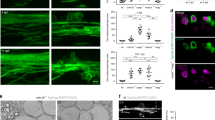Abstract.
Neuropilin is a cell-surface glycoprotein that was first identified in Xenopus tadpole nervous tissues and then in chicken and mouse. The primary structure of neuropilin is highly conserved among these vertebrate species. The extracellular part of the molecule is composed of three domains referred to as a1/a2, b1/b2, and c, each of which is expected to be involved in molecular and/or cellular interactions. Neuropilin can mediate cell adhesion by heterophilic molecular interaction. In all vertebrate species examined, the neuropilin protein is restricted to axons of particular neuron classes, and at stages when axon growth is active. The gain and loss of function of neuropilin in developing mouse embryos causes defasciculation and incorrect sprouting of nerve fibers. These findings suggest that neuropilin serves in a variety of neuronal cell interactions by binding to a variety of molecules, and that it plays essential roles in nerve fiber fasciculation and guidance.
Similar content being viewed by others
Author information
Authors and Affiliations
Additional information
Received: 5 May 1997 / Accepted: 11 June 1997
Rights and permissions
About this article
Cite this article
Fujisawa, H., Kitsukawa, T., Kawakami, A. et al. Roles of a neuronal cell-surface molecule, neuropilin, in nerve fiber fasciculation and guidance. Cell Tissue Res 290, 465–470 (1997). https://doi.org/10.1007/s004410050954
Issue Date:
DOI: https://doi.org/10.1007/s004410050954




